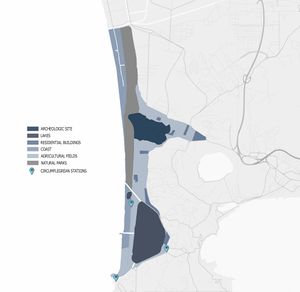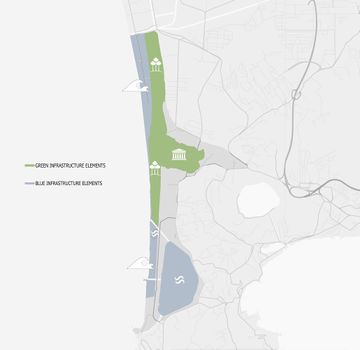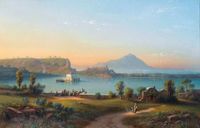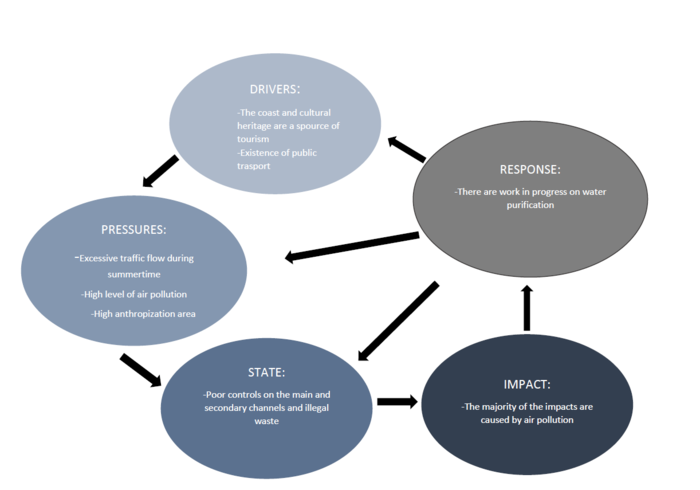Fusaro Lake-Cuma Coast
>>>back to working groups overview
| Area | Fusaro Lake-Cuma Coast | |
| Place | Bacoli | |
| Country | Italy | |
| Topics | please enter the main coast-related topics here | |
| Author(s) | Angela Ruggiero, Angela Vicidomini, Giacomo Santoro, Lucia Turiello | |

| ||
Rationale
The area of the Cuma Coast is one of great interest in the surroundings of Naples. Within its borders there are several emergencies concerning architecture, archeology and natural environment. Here the coastline is quite different, with wide sand beaches and traces of dunes so it has great potential to improve tourism. The inner part is quite chaotic due to illegal construction and messy urban planning. The idea is to rebuild the natural environment and create new and sustainable infrastructures in order to exploit at best the resources.
Location and scope
You can edit this map with the map editor
A Landscape System Analysis
A.1 Landscape layers and their system context
Geomorphology, landscape units and coastal typology
The area of study is part of the larger volcanic area of the Phlegraean Fields (Campi Flegrei in italian). The area of the caldera consists of 24 craters and volcanic edifices which have deeply transformed during the centuries. Despite the super volcano is dormant, hydrothermal activity and effusive gaseous manifestations can be currentley observed. The Acropolis of Cuma is itself part of one of the craters. The Fusaro Lake is, instead, a volcanic lake which formations is due to the blockage of volcanic materials which created a narrow coastal strip. The coastline is characterized by wide sand beaches with sand dunes and is currently menaced by erosion.
Land use
Beyond the costal belt, this particular area of the Phlegraean Fields is mainly occupied by agricultural fields and green areas. Especially the zone behind the coastline is characterized by the Natural Reserve of the Licola Coast and the Quarantena Natural Park, placed beside the Fusaro Lake. Only the remaining surface is taken by few residential buildings: the settlements are mostly messy and old, despite Bacoli great potential. The area used for agriculture could be the most likely to change because of the housing need, but it really is a protected area which can't be built to protect the biodiversity and the specific plantations. Cuma Coast is also rich of archeological sites which ,together with the costal landscapes, are the main resources for a tourism improvement. This characteristics makes Bacoli an ideal place for holidays; in fact, since its Roman foundation, the city has always been used as a vacation site. The area is also provided with three different stops of the Circumflegrean line, making it easy to reach both the lake and costal areas.
Green/blue infrastructure
It is clear how the study area holds a great environmental value, made by an intertwinement between nature, history and agricultural use: this is what makes the Cuma Coast a perfect scene for the creation of green and blue infrastructure, also according to the Bacoli 2004 P.U.C. (Municipality Urban Plan) main goals: sustainability, development of agricultural sites, increase of green areas and reduction of pollution.
- Green Infrastructure
The main elements on which establish a new wide green infrastructure are surely the Natural parks which are a wonderful background for the coast. Together with the parks, the agricultural heritage can also be a useful resource in order to build an infrastructure which involves a great biodiversity. This green infrastructure can be not only the vehicle for a revaluation of the natural assets but also for the cultural and archeological holdings.
- Blue Infrastructure
Surely the leading attraction of this area is the costal landscape, but the Cuma Coast is currently exploited by privates. The creation of new public and innovative services along the coast can improve the summer tourism but can also set up attractions usable the whole year. Obviously, the Fusaro Lake is the other main element that can be the ideal heart of a new blue infrastructure.
Actors and stakeholders
The area is mainly part of the Municipality of Bacoli. The main institutional actors involved are the same Municipality, the Basin Authortity (Autorità di bacino), the Provence of Naples and the Campania Region. Currently the Region is working on a coastline masterplan and, in partnership with the Emilia-Romagna Region, on an european project for the management of the coast. The Basin Authority (Autorità di bacino) is proceeding with the drafting of the Erosion Plans for Coastal Erosion, whose fundamental objectives are the identification of the areas at risk, within the stretch of coast in question, and the definition of guidelines for the implementation of coastal engineering interventions with particular reference to the defense of the areas considered as priority for the presence of high environmental criticalities.
The decision hierarchy cannot be considered univocal. We can say that the Municipality is the main decision maker because is the actor which can take practical decisions. The other actors contribuite to the decisions of the Municipality both with suggestions both with regulamentations. Citizens are, at last, the ones which influence these decision maker with their votes during elections.
Sacred spaces and heritage
The study area holds a special cultural interest, mainly because of the presence of the archeologic site of Cuma. Cuma is one of the oldest Roman colonies settled in Italy, founded in 730 b.C. The site of Cuma, explored in stages since 1606, but systematically only since 1852, is managed by the Superintendence for the Archaeological Heritage of Naples: most of the recovered finds are kept at the National Archaeological Museum of Naples and to the archaeological museum of the Campi Flegrei. Of the ancient city, just partly excavated, is possible to visit the lower part of the Roman city: the area of the Forum with its baths and public buildings, the Crypta Romana, and especially the acropolis with the Sibyl Cave and the Temples of Apollo and of Zeus. The splendid Arco Felice is a gateway to the city, a monumental brick arch from the Roman era.
In the heart of the city of Bacoli, you can also find another little archeologic site, called the "Colombario": it is a funerary building used to save ossuaries but in the past it was disguised as a place to host birds, and that's the reason of the name (colomba is the italian for dove).
The area of the Fusaro lake was one of the favorite hunting sites of Ferdinand IV of Bourbon who, to the south-east of the lake above a small island, gave rise to the beautiful Royal Casino. A jewel of late eighteenth-century architecture, one of the most significant of the Campi Flegrei, the so called "Casina Vanvitelliana" built to a design by Carlo Vanvitelli in 1782.
Visual appearance and landscape narrative
The Phlegraean Fields have an enormous historical and environmental importance for numerous reasons which makes this part of Campania one of the most fascinating places of Italy. Throughout the centuries, this area has been visited by a lot of people, becoming a great inspiration for famous painters and writers.
If we look at the past, Virgilio writes about it in the “Aeneid” in which Lake Fusaro represents the legendary “Acherusie palus”, that is the infernal marsh formed by the river Acheron. Seneca, instead, describes the residence of Roman Senator Vatia, underlining its favorable position which allowed the view on the sea and an excellent exposure to the winds (Letters to Lucilius, book XX, ep. VI).
This area was one of the destination of the Grand Tour from the seventeenth to the nineteenth century, during which the richest young people of all Europe learned, trough the journey, about art, culture, politics of the other countries. They note what they discovered in their travel diares. Among these, Goethe, in his Journey in Italy, gives a wide description of the area.
"The surroundings of Naples are the most wonderful in the world. The destruction and chaos of the volcanoes incline the soul to imitate the criminal hand of nature ... "We," I said to my friends, "resemble these volcanoes and the virtuous people in the monotonous and desolate Piedmontese plain. »
(Donatien Alphonse François de Sade)
Jakob Philipp Hackert, Goethe’s friend, works in Italy for Ferdinand I, King of the Two Sicilies. He is the painter of “Ferdinand IV chasing coots on the Lake Fusaro”, a documentary canvas on which the sovereign and his court are depicted during a hunting trip, probably in November. The scene is divided in two parts by an enormous tree which gives repair to people on the coast: on the left there’s the court; on the other part there’s the Casina Vanvitelliana, a suggestive hunting lodge made by the Italian architect Luigi Vanvitelli. The canvas is now preserved in the National Museum of Capodimonte.
In the same years, the swiss artist Johann Rudolf Buhlmann paints the “Lake Fusaro with Casina Reale”, too.
Among the Italian artists, Achille Carelli gives us a glimpse of the lake, as it appeared in the XIX century. His point of view includes the ruins of the so-called “Grotte dell’Acqua” which were part of an ancient Roman villa. During XX century to nowadays, Phlegraean Fields are also chosen by famous directors as scene for their films.
A.2 Summary of you landscape system analysis and your development Targets
The area is part of a delicate eco-system. According to several researches and studies, by 2100, due to global warming, the sea level will rise and a large part of the italian coastline will be affected and likely disappear. Serious actions are need to be taken in order to prevent this scenario; most of the Sustainable Development Goals can't be pursued locally but the Municipality could work on projects to improve the management of the city and its resiliency. As earlier mentioned, the Regional administration is working on a masterplan to regenerate the coastline but results haven't been disclosed yet.
The area of Bacoli is rich in architectural and cultural elements such as: The archeological site of Cuma, the Crypta Romana, the Sybil cave, The Temple of Apollo and Zeus, the Colombario and a wide presence of green areas and natural parks. Moreover the area is well connected by the Circumflegrea line. Among the negative aspects that this area holds, there is an important issue of air pollution and problems related to car traffic that inreases during the summer season, being this a tourist destination. In addiction there are serious issues caused by illegal waste disposal which makes useless the functioning of water purifiers. For this reason there are work in progress on the purification of water.
A.3 Theory reflection
Landscape and costal emergencies are analyzed in different international and national documents, which are about the same challenges the Cuma coast is facing.
Internationally, the Urban Agenda observes the outcomes of a weak urban planning and of an improper territory management, which is what affects the landscape of the Cuma Coast: unsuitable accommodations, pollution and disaster risks. Even if every country has got local peculiarity, the challenges are similar and so are the answers; not only is needed a partnership between national and regional government but also a collaboration within the local society itself. The main goal decided during the Quito conference is to create “livable cities”, which is reachable only thanks to “an accurate resources management, the environmental and cultural heritage endorsing and an infrastructure improvements”.
The Maritime Spatial Planning European Strategy for more Growth and Jobs in Coastal and Maritime Tourism is an important European document. The main interest of it concerns about how human activities at sea could be efficient, safe and sustainable. The Council has adopted a legislation to create a common framework for maritime spatial planning in Europe. The purpose is to reduce conflicts, encourage investments, increase cross-border cooperation, protect the environment. The UE members support the planning by making their own projects to facilitate cooperation between the countries. They focus their attention on themes such as: fishing and aquaculture, energy, maritime tourism, shipping, environment and so on.
Italy legislation is provided, instead, with the Code of Cultural Heritage and Landscape, approved in 2004. By landscape we mean the expressive territory of identity, whose character derives from the action of natural and human factors and their interrelation. With reference to the landscape, the enhancement includes the redevelopment of buildings and areas subject to protection compromised or degraded, or the creation of new coherent and integrated landscape values. The enhancement of the landscape contributes to promote the development of culture. To this end, public administrations promote and support, as far as their respective competences are concerned, specific activities of knowledge, information and training, redevelopment and use of the landscape and, where possible, the realization of new coherent and integrated landscape values.
A.4 References
- Cuma, la prima città greca d'Italia
- Visita al complesso borbonico del lago Fusaro
- Il lago Fusaro
- Il lago Fusaro e le sue ostriche
- Difesa del suolo
- NASA Sea Level Change Portal: Projections
- Codice dei Beni Culturali e del Paesaggio
- Habitat III
Phase B: Landscape Evaluation and Assessment
B.1 Assessment Strategy
- Based on the hypothesis derived from your previous landscape systems analysis you are now asked to define the goals for assessing the landscape. Your assessment is the basis for evaluating the landscape status.
- Which elements and phenomena need to be mapped, why and how?
- This a text contribution, max 250 words
B.2 Mapping
- As defined by your assessment strategy you conduct the mapping and present your findings here
- As a minimum, at least three different themes need to be mapped, you may choose more if needed
- Your case your assessment mapping themel.jpg
briefly explain the findings of your mapping
- Your case your assessment mapping theme2.jpg
briefly explain the findings of your mapping
- Your case your assessment mapping theme3.jpg
briefly explain the findings of your mapping
B.3 Problem definition and priority setting
- Give a summary of the major findings of your mapping process, what are the problems/potentials identified?
- Draw a problems/potentials map
- Set priorities for the most relevant issues
- Your case problems potentials map.jpg
add caption here
B.4 Theory reflection
- Please reflect the assessment and evaluation methods used based on at least three readings
- Did you encounter limitations'
- 200 words test contribution
B.5 References
- give a full list of the references you have used for this section
Phase C – Strategy and Master Plan
C.1 Goal Setting
- Define strategic planning objectives based on the evaluation findings
- Link back to your original targets from section one and the Development Goals
- 150 words text contribution
C.2 Spatial Strategy and Transect
- translate your strategic goals into a vision
- develop a spatial translation of your vision
- exemplify your vision in the form of a transect with concrete interventions
- add map(s) and visualizations
- Your case spatial translaton vision.jpg
add caption here
- Your case transect.jpg
add caption here
- Your case transect detail1.jpg
add caption here
- Your case transect detail2.jpg
add caption here
C.3 From Theory of Change to Implementation
- For implementing your vision: Which partnerships are needed? Which governance model is required?
- Who needs to act and how? Draw and explain a change/process model/timeline
- Which resources are needed? On which assets can you build?
- add 150 words text and visuals
- Your case spatial your governance model.jpg
add caption here
- Your case spatial your process model.jpg
add caption here
C.4 References
- give a full list of the references you have used for this section
D. Process Reflection
- Reflect in your intercultural and interdisciplinary team on the outcomes of your study
- Which limitations were you facing?
- What have you learnt from each other?
- What would you do differently next time?
- You can also use diagrams/visuals
- 250 words text












